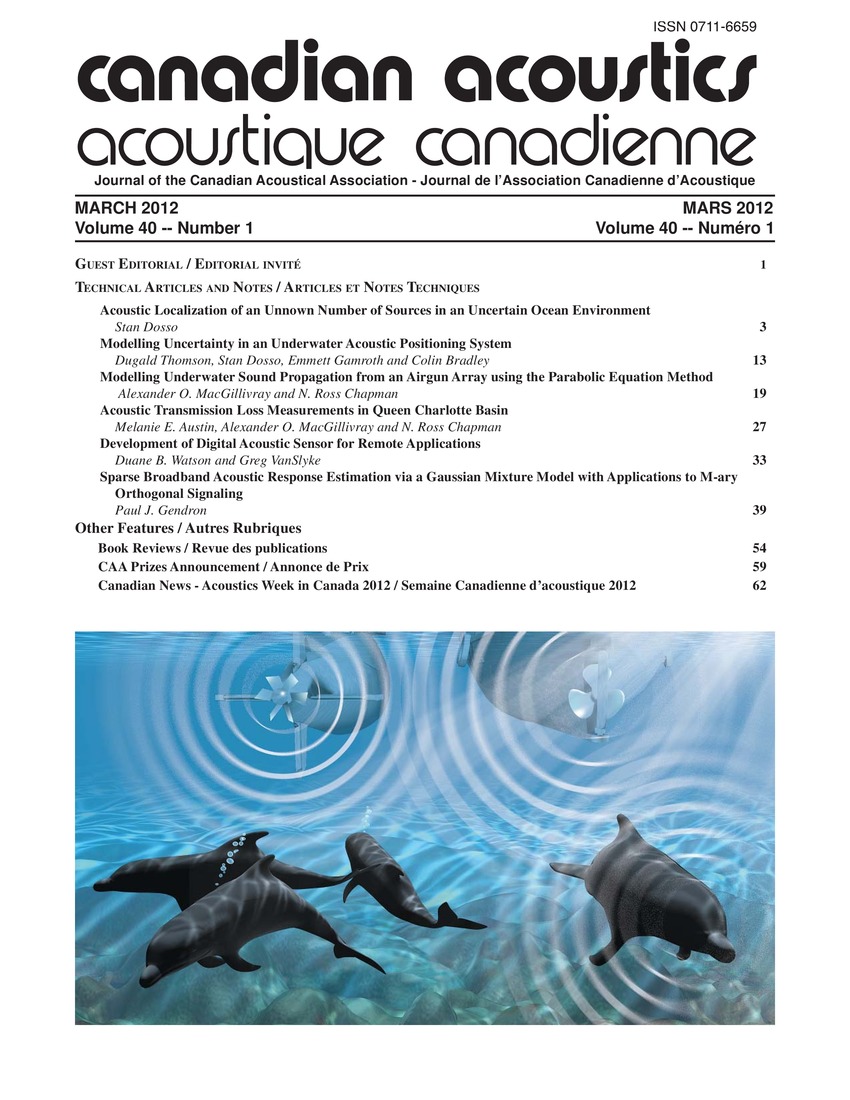Sparse broadband acoustic response estimation via a gaussian mixture model with application to m-ary orthogonal signaling
Keywords:
Acoustic fields, Algorithms, Bandwidth, Bit error rate, Estimation, Frequency estimation, Acoustic communications, Acoustic path, Acoustic response, Acoustic response function, Acoustic systems, Channel bandwidth, Channel dynamics, Combining method, Doppler, Estimation and compensation, Gaussian Mixture Model, Gaussian mixtures, Gaussian model, High frequency, Maximal path, Nova Scotia, Orthogonal signaling, Orthogonal signals, Per-symbol, Propagation media, Receiver algorithms, Recursive least square (RLS), Response functions, Shallow water acoustics, Signal duration, Single element, Temporal variabilityAbstract
Shallow water acoustic response functions at high frequencies and large bandwidths exhibit spatio- temporal variability that depends greatly on the propagation media's volume and boundary conditions as well as system source-receiver motion. For this reason practical acoustic systems invariably must operate without perfect knowledge of the space-time state of the ocean media. Considered here is a Gaussian mixture assignment over Doppler and channel bandwidth employed to describe the amplitude and phase of such acoustic response functions over signal duration and bandwidth that can serve in many scenarios to replace recursive least squares and Kalman-like algorithms. The mixtue Gaussian model of channel dynamics allows for the accurate and adaptive description of the response function. The model is flexible and naturally accommodates varying degrees of observed channel spar- sity. Posterior expectations are derived and shown to be soft shrinkage operators over Doppler-channel frequency. The model allows for novel and accurate estimates regarding the aggregate acoustic path dilation process that serve to replace conventional phase locked loops. This adaptive filtering scheme with aggregate path dilation estimation and compensation is tested on M-ary orthogonal signals at both 1 and 2 bits per symbol during the Unet08 acoustic communication experiments. These tests took place in the downward refracting, lossy bottom environment of St. Margaret's Bay Nova Scotia off of the R/V Quest. Receiver algorithms based on this approach were applied to a single element acoustic time series and empirical bit error rates demonstrate a 4 dB improvement over rank based maximal path combining methods. For a single hydrophone at 2 bits per symbol a bit error rate of less than 10-4 is observed at received SNR < -10 dB corresponding to an SNR/bit < 14 dB.Additional Files
Published
How to Cite
Issue
Section
License
Author Licensing Addendum
This Licensing Addendum ("Addendum") is entered into between the undersigned Author(s) and Canadian Acoustics journal published by the Canadian Acoustical Association (hereinafter referred to as the "Publisher"). The Author(s) and the Publisher agree as follows:
-
Retained Rights: The Author(s) retain(s) the following rights:
- The right to reproduce, distribute, and publicly display the Work on the Author's personal website or the website of the Author's institution.
- The right to use the Work in the Author's teaching activities and presentations.
- The right to include the Work in a compilation for the Author's personal use, not for sale.
-
Grant of License: The Author(s) grant(s) to the Publisher a worldwide exclusive license to publish, reproduce, distribute, and display the Work in Canadian Acoustics and any other formats and media deemed appropriate by the Publisher.
-
Attribution: The Publisher agrees to include proper attribution to the Author(s) in all publications and reproductions of the Work.
-
No Conflict: This Addendum is intended to be in harmony with, and not in conflict with, the terms and conditions of the original agreement entered into between the Author(s) and the Publisher.
-
Copyright Clause: Copyright on articles is held by the Author(s). The corresponding Author has the right to grant on behalf of all Authors and does grant on behalf of all Authors, a worldwide exclusive license to the Publisher and its licensees in perpetuity, in all forms, formats, and media (whether known now or created in the future), including but not limited to the rights to publish, reproduce, distribute, display, store, translate, create adaptations, reprints, include within collections, and create summaries, extracts, and/or abstracts of the Contribution.


